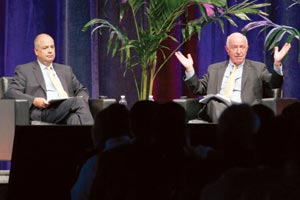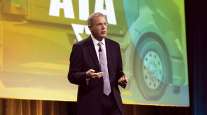Trucking Benefiting From Economic Growth; Analysts Say US in World’s Strongest Position

PHILADELPHIA — Its sluggishness aside, the U.S. economy is now, and will remain well into 2016, the world’s strongest producer and trucking will benefit from that, two economists said as part of their forecasts here.
The nation needs to work off a temporary bloating of inventories but then will resume an underlying growth pattern of 2.5% per year or more, said Bob Costello, chief economist at ATA, and Nariman Behravesh of IHS Inc.
They offered their analysis here Oct. 18 at the annual Management Conference & Exhibition of American Trucking Associations.
COMPLETE COVERAGE: MCE 2015
In a glimpse of other nations, Behravesh said China’s official growth rate of 7% a year probably is overstated, Brazil is suffering through a recession and Russia has that, plus self-inflicted troubles from a war and sanctions. India, he said, now is growing more rapidly than China.
As for the United States, he said it is close to full employment and the risk of inflation is low. The domestic economy is doing well but exports are a problem, Behravesh said, because the U.S. dollar is very strong, making it hard for manufacturers to export their goods.
Costello said increases in goods kept on shelves cut into the need for businesses to order replacements. Part of the decision by the nation’s firms to hold more comes from how trucking worked last year, he said.
“I’ve talked to shippers, and the capacity constraints we saw in 2014 were like nothing we’ve ever seen before,” he said. Therefore, shippers decided to increase inventory levels, but the economy “took a breather.”
Costello said the bulge in inventory levels is not so large as to cause great worry, however.
“The U.S. economy is on solid footing,” he said. “When this inventory adjustment is done, there will be a high volume of freight.”
The demand for trucking services should boost both the truckload and less-than-truckload sectors, he said. Earlier this decade, the tank truck group enjoyed the greatest demand, but now that spot has moved to refrigerated carriers, Costello said.
Behravesh said the nation will enjoy “decent growth but not gangbusters.”
The housing market is enjoying strong fundamentals, Behravesh said. Household formation — people getting married and then having children — is on the rise again after slowing during the recession.
Mack Trucks President Stephen Roy agrees with the assessment. He said his sales of vocational trucks, including dump trucks and cement mixers for construction, are doing well.
“Other than energy-related vehicles, we’re up in all vocational sales,” he said.
Added Philip Byrd, Sr. CEO of Bulldog Hiway Express: “I’m excited about the opportunities from the housing market.”
But Byrd warned that the housing prediction also carries a danger because a construction boom gives current and potential truck drivers yet another job option.
One of the persistent complaints about the U.S. economy has been wage stagnation. While the unemployment rate dropped to 5.1% in August and September from a high of 10% in October 2009, wages have been largely static.
Both economists said that may change soon as the U.S. labor market heats up.
“Labor markets are about to become tight,” Behravesh said, adding that employment shortages are not unique to trucking. Just as fleets are always on the prowl for more drivers and technicians, “many industries are reporting it’s hard to find skilled workers.”
Costello said the driver shortage “is as bad as ever,” and is even creeping into the LTL sector and private fleets — two parts of trucking that usually enjoy stable employment.
ATA’s new chairman, Pat Thomas, senior vice president of state government affairs at UPS Inc., No. 1 on the Transport Topics Top 100 list of U.S. and Canadian for-hire carriers, said during a press conference that even his company is finding the driver market more difficult than five years ago.
One good aspect of a hotter employment market is that “consumer spending is the lifeblood and mainstay of the economy,” Behravesh said.
And those goods will need to be transported, mostly by truck.



